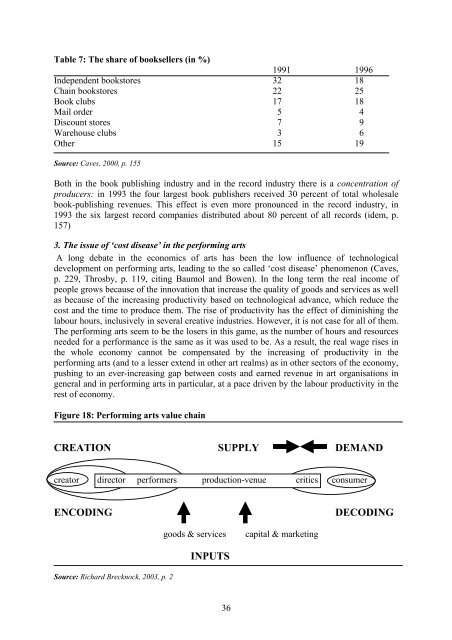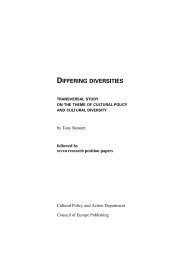Table 7: The share <strong>of</strong> booksellers (in %)1991 1996Independent bookstores 32 18Chain bookstores 22 25Book clubs 17 18Mail order 5 4Discount stores 7 9Warehouse clubs 3 6Other 15 19Source: Caves, 2000, p. 155Both in the book publishing industry and in the record industry there is a concentration <strong>of</strong>producers: in 1993 the four largest book publishers received 30 percent <strong>of</strong> total wholesalebook-publishing revenues. This effect is even more pronounced in the record industry, in1993 the six largest record companies distributed about 80 percent <strong>of</strong> all records (idem, p.157)3. The issue <strong>of</strong> ‘cost disease’ in the per<strong>for</strong>ming artsA long debate in the economics <strong>of</strong> arts has been the low influence <strong>of</strong> technologicaldevelopment on per<strong>for</strong>ming arts, leading to the so called ‘cost disease’ phenomenon (Caves,p. 229, Throsby, p. 119, citing Baumol and Bowen). In the long term the real income <strong>of</strong>people grows because <strong>of</strong> the innovation that increase the quality <strong>of</strong> goods and services as wellas because <strong>of</strong> the increasing productivity based on technological advance, which reduce thecost and the time to produce them. The rise <strong>of</strong> productivity has the effect <strong>of</strong> diminishing thelabour hours, inclusively in several creative industries. However, it is not case <strong>for</strong> all <strong>of</strong> them.The per<strong>for</strong>ming arts seem to be the losers in this game, as the number <strong>of</strong> hours and resourcesneeded <strong>for</strong> a per<strong>for</strong>mance is the same as it was used to be. As a result, the real wage rises inthe whole economy cannot be compensated by the increasing <strong>of</strong> productivity in theper<strong>for</strong>ming arts (and to a lesser extend in other art realms) as in other sectors <strong>of</strong> the economy,pushing to an ever-increasing gap between costs and earned revenue in art organisations ingeneral and in per<strong>for</strong>ming arts in particular, at a pace driven by the labour productivity in therest <strong>of</strong> economy.Figure 18: Per<strong>for</strong>ming arts value chainCREATION SUPPLY DEMANDcreator director per<strong>for</strong>mers production-venue critics consumerENCODINGDECODINGgoods & servicescapital & marketingINPUTSSource: Richard Brecknock, 2003, p. 236
Throsby shows that the implications <strong>of</strong> the cost disease phenomenon have been clarified overthe thirty five years so since Baumol and Bowen first put it <strong>for</strong>ward. The problem is moreacute in per<strong>for</strong>ming arts than in others because many <strong>of</strong> the project costs in this field are fixedand the productivity rate is quite stable. The individual and social actors <strong>of</strong> the creativeindustries have been trying to evade the problem using production and distributionadjustments: technical changes were introduced in scene design, sound or lighting facilities –enabling larger audience <strong>for</strong> a live per<strong>for</strong>mance; media reproduction technology extendedconsumption much further; the number <strong>of</strong> per<strong>for</strong>mances have been increased in the case <strong>of</strong>per<strong>for</strong>ming arts or by substituting creative products in visual arts; partnerships between artorganisations and corporate enterprises have been continuously developed. Beside thesefactors, rising consumer incomes and changing tastes led to an increasing demand <strong>for</strong> arts,even if the demand is spread non-equally among the different art <strong>for</strong>ms. According toThrosby, the gap will never increase so much as to be terminal <strong>for</strong> the sector: “the combinedimpacts <strong>of</strong> production adjustments, increased demand and generally rising level <strong>of</strong> unearnedrevenue have countered any tendency towards a secular rise in deficits among art companies,suggesting that although the cost disease will doubtless continue to present such companieswith difficult problems, it is unlikely to be terminal” (Throsby, 2001, p. 119). However, evenif the cost disease effect is not terminal to the high culture realm in general and per<strong>for</strong>mingarts in particular, it still might shrink the sector, legitimising the necessity <strong>for</strong> public subsidyand financial support from other sources.4. Toys and gamesAs Caves shows, lots <strong>of</strong> new toys are created and distributed on the market each year (about6000 just in the US market). Some remain on the market on long time (Barbie, etc.) otherdisappear after only a few years (Cabbage Patch Kids), but most <strong>of</strong> them disappear after oneseason. About 60 percent <strong>of</strong> toys are sold in the last quarter <strong>of</strong> each year. The promotion <strong>of</strong>toys registered a shift from the retailed channels to the massive promotion televisioncampaigns, with effects not only on the level <strong>of</strong> promotion but also on its substance. That isbecause they can be presented in action directly to the child, while the retail channels messagewas addressed mainly to the adult buyers. The toy innovation is made mainly by companieswhich are designers <strong>of</strong> toy and by the independent pr<strong>of</strong>essional designers. The traditionalroyalty rate received by an independent designer is 5 percent <strong>of</strong> net wholesale revenuerealized (according to Caves, 2000, p. 211-213).For video games, the producers <strong>of</strong>fer a combination <strong>of</strong> a hardware console and the gamess<strong>of</strong>tware which will be played on it. In 1998 the U.S. market was dominated by Sony (51percent <strong>of</strong> hardware - focused on older players) and Nintendo (41 percent – oriented to the 10-to-14 age group). The price differentials are explained by the following: Nintendo’s games areon cartridges – quite expensive to produce, but fast playing; Sony’s games are on CDs –cheap to produce but slower to play. While console selling gets thin pr<strong>of</strong>it margins, the gamesmake much bigger pr<strong>of</strong>its. As a consequence, Sony sell a large number <strong>of</strong> CD-based games<strong>for</strong> moderate prices, Nintendo a smaller quantity <strong>of</strong> very popular games but at higher prices(Caves, idem, p. 215).37














